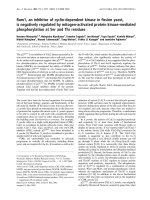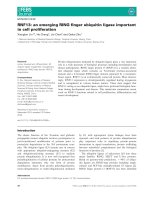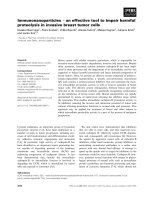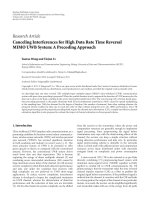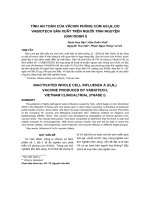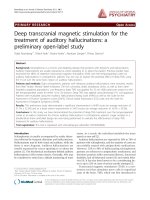Báo cáo y học: "NGAL: an emerging tool for predicting severity of AKI is easily detected by a clinical assay" potx
Bạn đang xem bản rút gọn của tài liệu. Xem và tải ngay bản đầy đủ của tài liệu tại đây (120.28 KB, 2 trang )
Expanded Abstract
Citation
Bennett M, Dent CL, Ma Q, Dastrala S, Grenier F,
Workman R, Syed H, Ali S, Barasch J, Devarajan P: Urine
NGAL predicts severity of acute kidney injury after
cardiac surgery: a prospective study. Clin J Am Soc
Nephrol 2008, 3:665-673 [1].
Background
e authors have previously shown that urine neutrophil
gelatinase-associated lipocalin (NGAL), measured by a
research ELISA, is an early predictive biomarker of acute
kidney injury (AKI) after cardiopulmonary bypass (CPB).
e availability of a standardized clinical platform for
NGAL measurements could revolutionize renal diag-
nostics, especially in intensive care situations.
Methods
Objective: e fi rst objective of the present study was to
determine whether an NGAL immunoassay developed
for a standardized clinical platform (ARCHITECT® ana-
ly zer, Abbott Diagnostics) correlates with the research-
based assay. e second objective was to determine the
utility of the standardized NGAL immunoassay as a
predictive biomarker of AKI after CPB in a large
prospective cohort.
Design: Prospective cohort study
Setting: Children’s hospital at a large US academic
medical center.
Subjects: 196 children undergoing elective CPB for
surgical correction or palliation of congenital heart
lesions between January 2004 and June 2006.
Intervention: None.
Outcomes: e primary outcome variable was the
development of AKI, defi ned as a 50% or greater increase
in serum creatinine from baseline. Other outcomes
included percent change in serum creatinine, days in
AKI, dialysis requirement, length of hospital stay, and
mortality.
Results
In a pilot study with 136 urine samples (NGAL range, 0.3
to 815 ng/ml) and 6 calibration standards (NGAL range,
0 to 1000 ng/ml), NGAL measurements by research
ELISA and by the ARCHITECT assay were highly corre-
lated (r = 0.99). In a subsequent study, serial urine NGAL
measurements were obtained by ARCHITECT assay. Of
the 196 children undergoing CPB, AKI developed in 99
patients (51%), but the diagnosis using serum creatinine
was delayed by 2 to 3 d after CPB. In contrast, mean
urine NGAL levels increased 15-fold within 2 h and by
25-fold at 4 and 6 h after CPB. For the 2-h urine NGAL
measurement, the area under the curve was 0.95,
sensitivity was 0.82, and the specifi city was 0.90 for
prediction of AKI using a cutoff value of 100 ng/ml. e
2-h urine NGAL levels correlated with severity and
duration of AKI, length of stay, dialysis requirement, and
death.
Conclusions
Accurate measurements of urine NGAL are obtained
using the ARCHITECT® platform. Urine NGAL is an
early predictive biomarker of AKI severity after CPB.
Commentary
Acute kidney injury (AKI) is estimated to occur in 5% of
hospitalized patients and as many as two thirds of
intensive care unit patients [2]. Early detection of acute
kidney injury could facilitate timely intervention before
irreversible injury has occurred, with the goal of limiting
morbidity and mortality. Unfortunately, the current
diagnosis of AKI is based predominantly on changes in
serum creatinine, which may not manifest for several
hours after the initial insult. ere is an ongoing search
to identify early biomarkers of AKI that would play a role
similar to that of troponin in acute myocardial infarction.
Neutrophil Gelatinase-Associated Lipocalin (NGAL) is
© 2010 BioMed Central Ltd
NGAL: an emerging tool for predicting severity of
AKI is easily detected by a clinical assay
Wes Gabbard,
1
Eric B Milbrandt
2
and John A Kellum*
3
University of Pittsburgh Department of Critical Care Medicine: Evidence-Based Medicine Journal Club, edited by Eric B Milbrandt
JOURNAL CLUB CRITIQUE
*Corresponding author:
3
Professor, Department of Critical Care Medicine, University of Pittsburgh School of
Medicine, Pittsburgh, Pennsylvania, USA
Full list of author information is available at the end of the article
Gabbard et al. Critical Care 2010, 14:318
/>© 2010 BioMed Central Ltd
rapidly released by renal tubules in response to injury.
Urinary NGAL is an early predictor of AKI in a variety of
acute clinical settings [3]. Most of the studies evaluating
NGAL as a predictor of AKI used a research-based
ELISA assay. e availability of a standardized clinical
platform for NGAL measurement would make this
promising new biomarker more widely available.
e current study by Bennett and colleagues was
conducted to accomplish two goals [1]: e fi rst was to
determine whether a new standardized clinical assay for
urinary NGAL correlated closely with the research assay.
e second was to determine whether urinary NGAL
levels obtained using the new clinical assay could accu-
rately predict AKI after cardiopulmonary bypass (CBP)
in children. e authors successfully accomplished both
goals. e new clinical assay was highly correlated with
the research assay (r=0.99) and highly predictive of post-
CPB AKI. A urinary NGAL threshold of 100 ng/ml at just
two hours post-CPB predicted the subsequent develop-
ment of AKI with an area under the receiver operating
characteristic (ROC) curve of 0.95 and a corres ponding
sensitivity and specifi city of 0.82 and 0.90. Furthermore,
this same 2-hour NGAL level correlated with severity
and duration of AKI, length of stay, dialysis requirement,
and death.
is was a well-done study showing the promise of a
new clinical assay and affi rming the signifi cant delay in
diagnosing AKI via changes in serum creatinine, which
did not show statistical diff erences until 48 hours after
CPB. ough this study was limited to children under-
going CPB, subsequent studies and a meta-analysis have
confi rmed the utility of both urinary and plasma/serum
NGAL for the early detection of AKI in other patient
populations, including adults [4] and in mixed medical-
surgical intensive care unit patients [5]. Importantly, the
relationship between urinary NGAL and AKI after CBP
in adults varies with baseline renal function [6].
Postoperative NGAL best indentifi ed AKI in patients
with baseline glomerular fi ltration rates (GFR) of 90 to
120 ml/min. In patients with baseline GFR <60 ml/min,
urinary NGAL did not diff er at any time between those
who did and did not develop AKI.
Recommendation
NGAL and other novel biomarkers such as cystatin C [7]
can lead to rapid detection of AKI. A strategy of early
biomarker-driven detection and subsequent intervention
may lead to improved outcomes and warrants further
study.
Competing interests
The authors declare no competing interests
Author Details
1
Clinical Fellow, Department of Critical Care Medicine, University of Pittsburgh
School of Medicine, Pittsburgh, Pennsylvania, USA.
2
Assistant Professor,
Department of Critical Care Medicine, University of Pittsburgh School of
Medicine, Pittsburgh, Pennsylvania, USA.
3
Professor, Department of Critical
Care Medicine, University of Pittsburgh School of Medicine, Pittsburgh,
Pennsylvania, USA.
Published: 23 August 2010
References
1. Bennett M, Dent CL, Ma Q, Dastrala S, Grenier F, Workman R, Syed H, Ali S,
Barasch J, Devarajan P: Urine NGAL predicts severity of acute kidney injury
after cardiac surgery: a prospective study. Clin J Am Soc Nephrol 2008,
3:665-673.
2. Hoste EA, Clermont G, Kersten A, Venkataraman R, Angus DC, De Bacquer D,
Kellum JA: RIFLE criteria for acute kidney injury are associated with
hospital mortality in critically ill patients: a cohort analysis. Crit Care 2006,
10:R73.
3. Devarajan P: Neutrophil gelatinase-associated lipocalin an emerging
troponin for kidney injury. Nephrol Dial Transplant 2008, 23:3737-3743.
4. Haase M, Bellomo R, Devarajan P, Schlattmann P, Haase-Fielitz A: Accuracy of
neutrophil gelatinase-associated lipocalin (NGAL) in diagnosis and
prognosis in acute kidney injury: a systematic review and meta-analysis.
Am J Kidney Dis 2009, 54:1012-1024.
5. Cruz DN, de Cal M, Garzotto F, Perazella MA, Lentini P, Corradi V, Piccinni P,
Ronco C: Plasma neutrophil gelatinase-associated lipocalin is an early
biomarker for acute kidney injury in an adult ICU population. Intensive Care
Med 2010, 36:444-451.
6. McIlroy DR, Wagener G, Lee HT: Neutrophil gelatinase-associated lipocalin
and acute kidney injury after cardiac surgery: the e ect of baseline renal
function on diagnostic performance. Clin J Am Soc Nephrol 2010, 5:211-219.
7. Haase-Fielitz A, Bellomo R, Devarajan P, Story D, Matalanis G, Dragun D, Haase
M: Novel and conventional serum biomarkers predicting acute kidney
injury in adult cardiac surgery a prospective cohort study. Crit Care Med
2009, 37:553-560.
doi:10.1186/cc9071
Cite this article as: Gabbard W, et al.: NGAL: an emerging tool for predicting
severity of AKI is easily detected by a clinical assay. Critical Care 2010, 14:318.
Gabbard et al. Critical Care 2010, 14:318
/>Page 2 of 2
